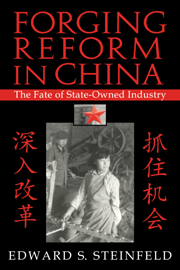Book contents
- Frontmatter
- Contents
- List of Tables and Figures
- Preface
- 1 Introduction: China's Ailing State Enterprises
- Part I Conceptual Approaches to Postsocialist Enterprise Reform
- Part II Enterprise Case Studies: The Commanding Heights in Transition
- Part III Reassessing Chinese Patterns of Economic Development
- Notes
- Bibliography
- Index
Preface
Published online by Cambridge University Press: 12 January 2010
- Frontmatter
- Contents
- List of Tables and Figures
- Preface
- 1 Introduction: China's Ailing State Enterprises
- Part I Conceptual Approaches to Postsocialist Enterprise Reform
- Part II Enterprise Case Studies: The Commanding Heights in Transition
- Part III Reassessing Chinese Patterns of Economic Development
- Notes
- Bibliography
- Index
Summary
As this book enters publication, China stands at the most critical juncture in its journey from plan to market. In the early months of 1998, as its neighbors were sinking deeper and deeper into financial distress, China embarked on a daring, headlong scramble to solve its own escalating economic woes, problems that had been accumulating for years if not decades. Realization had finally sunk in that the system was severely flawed and that drastic measures were necessary. The nation's banking system was mired in insolvency, levels of nonperforming loans were astronomical, and demand nationwide was dropping. During the preceding fifteen years, policy makers had achieved growth but had resisted any serious changes to a system that showered subsidized credit upon heavy industry. Now, living in the shadow of East Asia's financial meltdown, and with the specter of a Chinese financial collapse looming, policy makers are coming to understand the accumulated costs of deferred reforms. They are coming to understand that China, for all its uniqueness and for all its phenomenal success, has failed to avoid the scourge of rapidly developing economies East and West: inefficient capital allocation and grievous misinvestment. Determined to avoid the fate of its neighbors, China swung into action.
Zhu Rongji, formally elevated to the premiership in March of 1998, ushered in the spring with a reform package striking for its scale and severity. The banking system was to be wrenched from local control, nearly half of the central government's ministries were to be eliminated, almost four million bureaucrats were to be relieved of their positions, and subsidized credit to state firms was to be summarily cut.
- Type
- Chapter
- Information
- Forging Reform in ChinaThe Fate of State-Owned Industry, pp. xiii - xviiiPublisher: Cambridge University PressPrint publication year: 1998

